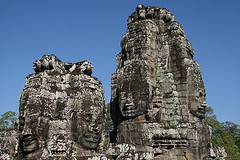Buddha-hopping across Gansu
Wednesday, April 29th, 2009From one end of the very elongated Gansu province to the other, it’s all been about Buddha caves for the past few days. Since Sunday we’ve been to three different ancient Buddhist complexes, each of which offer different types of experiences but ultimately the same outcome: leaving me in awe of the lengths these ancient craftsmen went to to glorify the religion.
We started at Maiji Shan, joining a few hundred Chinese tourists and one foreigner (the only one we saw in our six days in Eastern Gansu) at the site. What makes Maiji Shan extraordinary is that all the caves are built, higher and higher, into a near vertical cliff – all the way up to about 50m by my estimation. Most of the caves themselves are locked and only viewable through grates (which makes viewing difficult and photography impossible), but two groups of three enormous statues carved into the cliff more than make up for it and provide my definitive memory from the site. As you go up and up the modern staircases, so that you’re ultimately looking down on these enormous statues, you can’t help but be amazed at how this was achieved in the fourth century, and what drove the craftsmen to creating caves so high up that they couldn’t be enjoyed from the ground. In all, it was a memorable experience.
We visited a less famous site the following day, known as the Water Curtain Caves. We were extremely disappointed to see that the principle (and really, only) attraction there – a 31m high painted Buddha on a cliff face – was completely covered in scaffolding, so we could barely see it. Luckily we managed to sneak behind the scaffolding and look up at the gigantic depiction, a pretty humbling experience.
After an overnight train ride that took us far further west than we’ve ever been in China, we arrived in Dunhuang to see the most famous of all Buddhist caves in China. You’re not allowed to take cameras in, and you only get to see a rotating series of 10 of the caves (there are several hundred in all), but the artwork inside was quite spectacular, the most impressive of the four sites we’ve seen in Gansu by some distance. Overall perhaps the Yungang Caves that we saw last year were more awe-inspiring, but I thought Dunhuang was still worth the hype. Besides the glorious sculpture work and vivid painting, we also saw what is now – following the destruction of the Bamiyan Buddhas in Afghanistan by the Taliban – the world’s second-largest ancient Buddha statue at 36m high.
The other most interesting aspect of the past few days has been seeing rural China for, really, the first time. Old men in Mao suits, farmers in the fields by the sides of the road, traditional Chinese architecture still thriving in the numerous villages we’ve passed on buses – it all provides a nice contrast to the modern megacities of Beijing and Guangzhou that have defined so much of our China experience so far.
With only a few days left in Gansu, we’re going to see the fortress at the end of the Great Wall of China tomorrow and then try to see another Tibetan-style monastery. Meanwhile, photos are here.

